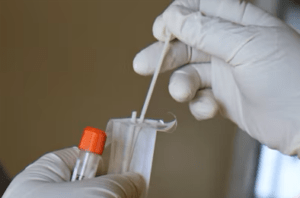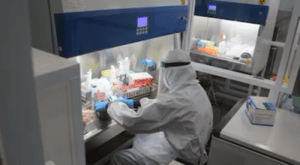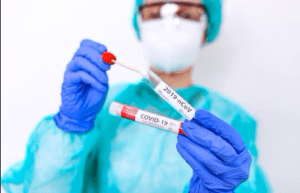Artikull nga Baydin Smith
Peptidet janë shfaqur si mjete kërkimore kritike për shkak të shkathtësisë dhe specifikës së tyre në ndikimin e proceseve fiziologjike. Ndër peptidet e shumta të hulumtuara, GRF 1-29 i Modifikuar dhe GHRP-2 dallohen për rolet e tyre plotësuese në modulimin e rrugëve të lidhura me rritjen. Ndërsa çdo peptid individualisht besohet se premton, vetitë e tyre të kombinuara mund të ofrojnë mundësi unike për avancimin e kërkimit në substancat rigjeneruese, metabolizmin dhe biologjinë qelizore.

Vështrime Strukturore dhe Mekanizma të Veprimit
GRF 1-29 i modifikuar është një analog i hormonit çlirues të hormonit të rritjes (GHRH) që është ndryshuar për të mbështetur stabilitetin dhe ndikimin e tij biologjik. GHRH amtare është një rregullator kyç i aktivitetit të boshtit somatotropik, kryesisht duke stimuluar gjëndrën e hipofizës për të lëshuar hormonin e rritjes. Megjithatë, forma e pamodifikuar e GHRH degradohet me shpejtësi nga aktiviteti enzimatik, duke kufizuar qëndrueshmërinë e saj në kërkime. Varianti i modifikuar përfshin zëvendësimet e aminoacideve të dizajnuara për t’i rezistuar prishjes enzimatike dhe për të zgjatur gjysmën e jetës së tij, duke e bërë atë potencialisht më të përshtatshëm për vëzhgimin e zgjatur të ndikimeve të tij në proceset qelizore.
GHRP-2, ose peptidi-2 që çliron hormonin e rritjes, i përket një klase të peptideve sintetike që besohet se janë sekretagogë. Studimet sugjerojnë se këto peptide mund të mbështesin sekretimin endogjen të hormonit të rritjes duke ndërvepruar me receptorin e grelinit (GHS-R1a). Ky receptor besohet të ketë një rol në rregullimin e homeostazës së energjisë, përhapjen qelizore dhe riparimin e indeve. Ndryshe nga GRF 1-29 i modifikuar, GHRP-2 teorizohet të ushtrojë ndikimin e tij jo vetëm nëpërmjet rrugëve të hormonit të rritjes, por edhe duke ndikuar në rrugët dytësore të lidhura me aktivitetin e receptorit të grelinës. Ky mekanizëm i dyfishtë veprimi sugjeron që GHRP-2 mund të modulojë një spektër më të gjerë të proceseve fiziologjike.

Kur kombinohen, dy peptidet janë spekuluar se shfaqin veti sinergjike, me GRF 1-29 të Modifikuar që përforcon përgjigjen ndaj sekretagogëve të hormonit të rritjes. Në të njëjtën kohë, GHRP-2 duket se mbështet lirimin e hormonit të rritjes dhe ndikon në rrugët plotësuese. Ndërveprimi i këtyre peptideve paraqet një zonë intriguese eksplorimi, pasi mund të japë rezultate më të fuqishme ose të ndryshme sesa secili peptid vetëm.
Implikimet e mundshme në kërkimin rigjenerues
Një nga implikimet e mundshme kërkimore më bindëse për përzierjen e modifikuar GRF 1-29 dhe GHRP-2 mendohet se qëndron në shkencën rigjeneruese. Hormoni i rritjes është i lidhur ngushtë me riparimin e indeve dhe rigjenerimin qelizor, dhe këto peptide supozohet se ofrojnë një model për të hetuar se si modifikimi i hormonit të rritjes ndikon në këto procese. Studimet sugjerojnë se peptidet mund të ndikojnë në përhapjen e qelizave paraardhëse dhe diferencimin e tyre në lloje të specializuara të qelizave, të cilat mund të jenë kritike për eksplorimin e opsioneve për lëndime ose kushte degjenerative.

Për më tepër, hulumtimi tregon se përzierja e peptideve mund të ofrojë njohuri në mekanizmat e shërimit të plagëve. Është supozuar se hormoni i rritjes stimulon prodhimin e proteinave të matricës jashtëqelizore si kolagjeni, të cilat janë jetike për integritetin strukturor të indeve. Duke ekzaminuar ndikimin e kombinimit të peptideve në këto rrugë, studiuesit mund të kuptojnë më tej se si rregullimi i hormonit të rritjes mbështet riparimin dhe rimodelimin e indeve.
Eksplorimi i Rrugëve Metabolike
Hetimet pretendojnë se ndërveprimi midis GRF 1-29 të Modifikuar dhe GHRP-2 mund të sigurojë gjithashtu njohuri të vlefshme për rregullimin metabolik. Hormonet e rritjes besohet se ndikojnë në metabolizmin e lipideve dhe karbohidrateve, dhe peptidet besohet se u mundësojnë studiuesve të hetojnë më saktë këto rrugë. Për shembull, gjetjet nënkuptojnë se ndërveprimi i mundshëm i GHRP-2 me receptorin e ghrelinës mund të ketë implikime për studimin e rregullimit të oreksit, shpenzimit të energjisë dhe dinamikës së indit dhjamor.
Për më tepër, peptidet janë hipotezuar se shërbejnë si mjete për të eksploruar homeostazën e glukozës dhe ndjeshmërinë ndaj insulinës. Duke modifikuar nivelet e hormonit të rritjes, studiuesit mund të vëzhgojnë ndryshime në prodhimin e faktorit të rritjes 1 të ngjashëm me insulinën (IGF-1) dhe ndikimet e tij në rrjedhën e poshtme në metabolizmin e glukozës. Kjo fushë e hetimit mund të mbajë premtime për zhvillimin e qasjeve të reja për të kuptuar çrregullimet metabolike, duke përfshirë diabetin dhe obezitetin, në modelet eksperimentale.

Vështrime mbi plakjen qelizore dhe jetëgjatësinë
Hulumtimi i plakjes qelizore përfaqëson një fushë tjetër intriguese për studimin e përzierjes së modifikuar GRF 1-29 dhe GHRP-2. Nivelet e hormonit të rritjes bien me kalimin e kohës, gjë që është shoqëruar me ulje të kapacitetit rigjenerues, ndryshime në funksionin metabolik dhe ndryshim të elasticitetit qelizor. Duke përdorur këto peptide, studiuesit mund të eksplorojnë se si modulimi i rrugëve të hormonit të rritjes mund të ndikojnë në shënuesit e plakjes qelizore.
Shkencëtarët spekulojnë se peptidet mund të ofrojnë njohuri mbi plakjen qelizore dhe autofagjinë, procese që janë thelbësore për plakjen qelizore. Për shembull, rrugët e hormonit të rritjes dhe IGF-1 janë implikuar në rregullimin e qarkullimit qelizor dhe heqjen e komponentëve të dëmtuar. Hetimet pretendojnë se përzierja e peptideve mund të modelojë ndikimin e rivendosjes së sinjalizimit të hormonit të rritjes në indet e moshuara, duke ofruar kështu një kornizë për të studiuar ndërhyrjet e mundshme që synojnë rritjen e jetëgjatësisë.
Hulumtimi mbi sistemet e indeve skeletore dhe muskulare
Aktiviteti i hormonit të rritjes ndikon drejtpërdrejt në sistemet e indeve skeletore dhe muskulare, dhe përzierja e modifikuar GRF 1-29 dhe GHRP-2 është hipotezuar për të ofruar mënyra të reja për të studiuar këto sisteme në mjedise eksperimentale. Hormoni i rritjes teorizohet se promovon ndjeshëm densitetin e kockave duke stimuluar aktivitetin e osteoblasteve dhe mbajtjen e kalciumit. Duke aplikuar këto peptide në modelet eksperimentale, studiuesit mund të ekzaminojnë bazat molekulare të rimodelimit dhe mineralizimit të kockave.
Në mënyrë të ngjashme, potenciali i peptideve për të stimuluar lirimin e hormonit të rritjes mund t’i bëjë ato mjete të vlefshme për studimin e fiziologjisë së indit muskulor. Hormoni i rritjes lidhet me sintezën e proteinave dhe hipertrofinë e indit muskulor, procese kritike për ruajtjen e masës dhe funksionit të indit muskulor. Përzierja e peptideve mund t’u mundësojë studiuesve të eksplorojnë se si modulimi i hormonit të rritjes ndikon në riparimin e qelizave të muskujve pas lëndimit ose atrofisë për shkak të mospërdorimit ose plakjes qelizore.
Ekspozimi i mundshëm në Kërkimet Neurobiologjike
Të dhënat në zhvillim sugjerojnë se hormoni i rritjes dhe rrugët e lidhura me të mund të luajnë një rol në neurobiologji. Studimet supozojnë se përzierja e modifikuar GRF 1-29 dhe GHRP-2 mund të shërbejë si një model i vlefshëm për hetimin e ndikimit të hormoneve të rritjes në shkencën neuronale, funksionin kognitiv dhe neurombrojtjen.
Është supozuar se hormoni i rritjes ndikon në neurogjenezën, veçanërisht në hipokampus, një rajon i trurit i lidhur me të mësuarit dhe kujtesën. Duke studiuar ndikimin e përzierjes së peptideve në këtë proces, studiuesit mund të eksplorojnë se si sinjalizimi i hormonit të rritjes ndërvepron me neuroplasticitetin dhe rimodelimin sinaptik. Për më tepër, ndërveprimi i GHRP-2 me receptorin e ghrelinës është propozuar për të ofruar njohuri shtesë mbi rolin e mundshëm të peptidit në rregullimin e modeleve të sjelljes dhe proceseve njohëse.
Konkluzioni
Përzierja e modifikuar e peptideve GRF 1-29 dhe GHRP-2 përfaqëson një mjet premtues për avancimin e kërkimit në fusha të ndryshme, duke përfshirë shkencën rigjeneruese, metabolizmin, plakjen qelizore, biologjinë muskuloskeletore dhe neurobiologjinë. Vetitë plotësuese të këtyre peptideve besohet se ofrojnë një mundësi unike për të eksploruar modulimin e hormonit të rritjes dhe implikimet e tij më të gjera. Ndërsa mbetet shumë për t’u zbuluar, shkathtësia e këtij kombinimi peptid nënvizon potencialin e tij për të kontribuar në mënyrë domethënëse në kuptimin e sistemeve komplekse biologjike dhe zhvillimin e strategjive të reja kërkimore. Klikoni këtu https://www.corepeptides.com/modified-grf-1-29-ghrp-2-studies-in-hormones-metabolism-and-growth/ për të marrë më shumë informacion.
Referencat
[i] Veldhuis, J. D., & Bowers, C. Y. (2003). Veprimet integruese të sekretagogëve të hormonit të rritjes në boshtin GH-IGF. Rishikimet Endokrine, 24 (6), 747-770.
[ii] Ravi, A., Kumar, T. R., & Woodruff, T. K. (2013). Rregullimi hormonal i rimodelimit të kockave: Vështrime nga terapitë me peptide. Bone, 54 (1), 15-21.
[iii] Smith, R. G., & Sun, Y. (2004). Peptidet si rregullatorë të boshtit somatotrop: Vështrime mekanike. Trendet në Endokrinologji dhe Metabolizëm, 15 (1), 35-41.
[iv] Ghigo, E., Arvat, E., & Gianotti, L. (1998). Peptidet që çlirojnë hormonin e rritjes dhe analogët e tyre. Kufijtë në Neuroendokrinologji, 19 (1), 47-72.
[v] Blum, W. F., & Breier, B. H. (1994). Analiza radioimune për IGF dhe IGFBP. Rregullorja e Rritjes, 4 (1), 11-19.





